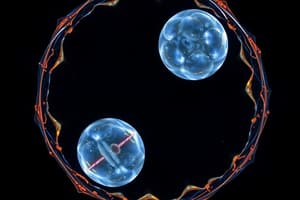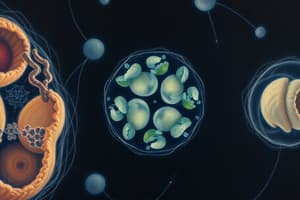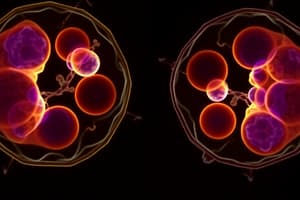Podcast
Questions and Answers
During which stage of meiosis II do centromeres divide and are pulled by spindle fibers to opposite poles?
During which stage of meiosis II do centromeres divide and are pulled by spindle fibers to opposite poles?
- Metaphase II
- Anaphase II (correct)
- Telophase II
- Prophase II
Which process produces daughter cells that are exact copies of the parental cell for growth, repair, and asexual reproduction?
Which process produces daughter cells that are exact copies of the parental cell for growth, repair, and asexual reproduction?
- Meiosis II
- Meiosis I
- Fertilization
- Mitosis (correct)
What occurs during the diplotene stage of meiosis?
What occurs during the diplotene stage of meiosis?
- Asymmetric cytokinesis occurs
- Crossing over between homologous chromosomes (correct)
- Oocytes grow to a large size
- Oocytes resume meiosis in response to hormonal stimulation
What is the significance of meiosis in producing offspring different from their parents?
What is the significance of meiosis in producing offspring different from their parents?
What process converts the spermatocyte into four spermatids?
What process converts the spermatocyte into four spermatids?
What prevents additional sperm from entering the egg during fertilization?
What prevents additional sperm from entering the egg during fertilization?
"Spindle develops at right angle to spindle of 1st meiotic division" occurs during which stage of meiosis?
"Spindle develops at right angle to spindle of 1st meiotic division" occurs during which stage of meiosis?
What happens when chromatids reach opposite poles during Telophase II?
What happens when chromatids reach opposite poles during Telophase II?
What is produced by crossing over between homologous chromosomes?
What is produced by crossing over between homologous chromosomes?
What happens during the first part of interphase?
What happens during the first part of interphase?
What is the process called when the cell makes an exact copy of its DNA during interphase?
What is the process called when the cell makes an exact copy of its DNA during interphase?
What happens to the threadlike chromatin in the cell's nucleus during prophase of mitosis?
What happens to the threadlike chromatin in the cell's nucleus during prophase of mitosis?
What is the name of the structure that holds together two chromatids in a chromosome during prophase?
What is the name of the structure that holds together two chromatids in a chromosome during prophase?
What is the stage during which the cell's nucleus divides into two new nuclei?
What is the stage during which the cell's nucleus divides into two new nuclei?
What happens during anaphase of cell division?
What happens during anaphase of cell division?
How does cytokinesis occur in plant cells?
How does cytokinesis occur in plant cells?
What is the role of the synaptonemal complex during meiosis?
What is the role of the synaptonemal complex during meiosis?
What marks the end of mitosis?
What marks the end of mitosis?
What is the process following mitosis?
What is the process following mitosis?
What happens during prophase I of meiosis?
What happens during prophase I of meiosis?
What is the result of meiosis?
What is the result of meiosis?
How do animal cells undergo cytokinesis?
How do animal cells undergo cytokinesis?
What happens to sister chromatids during metaphase?
What happens to sister chromatids during metaphase?
What occurs at diplotene during meiosis?
What occurs at diplotene during meiosis?
Flashcards
Mitosis
Mitosis
The process of cell division that produces two genetically identical daughter cells. This process is essential for growth, repair, and asexual reproduction.
Metaphase
Metaphase
The stage of mitosis when duplicated chromosomes line up along the middle of the cell.
Anaphase
Anaphase
The stage of mitosis when sister chromatids are pulled apart to opposite poles of the cell.
Telophase
Telophase
Signup and view all the flashcards
Meiosis
Meiosis
Signup and view all the flashcards
Prophase I
Prophase I
Signup and view all the flashcards
Metaphase I
Metaphase I
Signup and view all the flashcards
Anaphase I
Anaphase I
Signup and view all the flashcards
Telophase I
Telophase I
Signup and view all the flashcards
Anaphase II
Anaphase II
Signup and view all the flashcards
Spermatogenesis
Spermatogenesis
Signup and view all the flashcards
Surface alteration
Surface alteration
Signup and view all the flashcards
Prophase II
Prophase II
Signup and view all the flashcards
Telophase II
Telophase II
Signup and view all the flashcards
Crossing over
Crossing over
Signup and view all the flashcards
G1 phase
G1 phase
Signup and view all the flashcards
S phase
S phase
Signup and view all the flashcards
G2 phase
G2 phase
Signup and view all the flashcards
Centromere
Centromere
Signup and view all the flashcards
Cytokinesis in plant cells
Cytokinesis in plant cells
Signup and view all the flashcards
Synaptonemal complex
Synaptonemal complex
Signup and view all the flashcards
Cytokinesis in animal cells
Cytokinesis in animal cells
Signup and view all the flashcards
Metaphase
Metaphase
Signup and view all the flashcards
Desynapsis
Desynapsis
Signup and view all the flashcards
Meiosis I
Meiosis I
Signup and view all the flashcards
Meiosis II
Meiosis II
Signup and view all the flashcards
Study Notes
- The spindle apparatus moves to opposite poles of the cell during cell division.
- Sister chromatids are attached to centrioles and spindle fibers during prophase in both animal and plant cells.
- Chromosomes align themselves at the equator of the spindle during metaphase in both animal and plant cells.
- During anaphase, the spindle fibers shorten and the centromere splits, pulling separated sister chromatids towards opposite poles in both animal and plant cells.
- Telophase marks the end of mitosis, where chromosomes reach the poles and appear as chromatin, nuclear membranes reform, and new nuclei form.
- Cytokinesis is the process following mitosis, resulting in two daughter cells, coordinating nuclear and cytoplasmic division.
- In animal cells, cytokinesis is mediated by a contractile ring of actin and myosin filaments that forms beneath the plasma membrane and pinches the cell in half.
- Plant cells divide through the formation of new cell walls and plasma membranes inside the cell.
- Both animal and plant cells undergo cytokinesis, with the cytoplasm dividing and distributing organelles, and each resulting in two daughter cells with identical chromosomes.
- Meiosis is a process of cell division that gives rise to four haploid daughter cells, forming gametes or spores in plants.
- Prophase I is the first phase of meiosis, where chromosomes become visible and actively condense, and homologous chromosomes pair up and synapse, forming a bivalent.
- During prophase I, the synaptonemal complex forms along the length of the paired chromosomes, keeping them aligned and closely associated.
- Synapsis and recombination between homologous chromosomes are completed during pachytene, and the synaptonemal complex disappears at diplotene, allowing the homologous chromosomes to separate.
- At the end of meiosis I, the chromosomes are separated into two daughter cells, and meiosis II ensues, resulting in the formation of four haploid daughter cells.
Studying That Suits You
Use AI to generate personalized quizzes and flashcards to suit your learning preferences.




